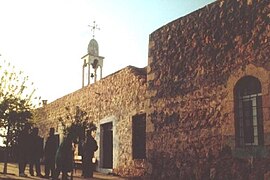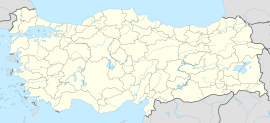Üçköy (Kurdish: Xarābê Alê;[2][a] Syriac: ܐܪܟܚ, romanized: Arkaḥ;[4][b] or Xarābāle)[2] is a neighbourhood in the municipality and district of Nusaybin, Mardin Province in Turkey.[6] The village is populated by Assyrians and had a population of 432 in 2021.[1][7] It is located in the historical region of Tur Abdin.[8]
Üçköy | |
|---|---|
 Church of Mor Ephraim and Mor Theodorus | |
| Coordinates: 37°15′29″N 41°26′13″E / 37.258°N 41.437°E | |
| Country | Turkey |
| Province | Mardin |
| District | Nusaybin |
| Population (2021)[1] | 432 |
| Time zone | UTC+3 (TRT) |
There is a Syriac Orthodox church of Mor Ephraim and Mor Theodorus.[9]
History
editArkaḥ (today called Üçköy) is mentioned in the Life of Malke, likely written in the ninth or tenth century, in which it is noted that Mor Malke resided near the village, where he performed several miracles and gained Šlémūn bar Wahbūn as a disciple.[10] The Mor Malke Monastery was founded near the village about the sixth century.[8] Arkaḥ was inhabited by adherents of the Church of the East until it was abandoned and eventually resettled by Syriac Orthodox Christians in the 1830s and the Church of Mor Ephraim and Mor Theodorus was rebuilt, however it was still in ruins when the village was visited by Gertrude Bell in 1909.[11]
The Syriac Catholic bishop Gabriel Tappouni recorded that the village was populated by 400 Syriac Orthodox Christians in 80 families and were served by one priest in 1913.[12] In 1914, Arkaḥ was inhabited by 300 or 400 Assyrians, according to the list presented to the Paris Peace Conference by the Assyro-Chaldean delegation.[c] Amidst the Sayfo, the village's population took refuge at the Mor Malke Monastery.[14] The population of the village was 743 in 1960.[2] There were 950 Turoyo-speaking Christians in 120 families in 1966.[2] In the late 20th century, a number of villagers emigrated to Germany.[15]
Demography
editThe following is a list of the number of Assyrian families that have inhabited Arkaḥ per year stated. Unless otherwise stated, all figures are from the list provided in Eastern Christianity, Theological Reflection on Religion, Culture, and Politics in the Holy Land and Christian Encounter with Islam and the Muslim World, as noted in the bibliography below.[16][d]
References
editNotes
- ^ Also spelt as Harabale, Harabali, Harab-Allé, Harapali, Kharaba Aleh, Kharabalé, or Kharabalī.[3] Nisba: Xarābālī.[2]
- ^ Alternatively translitered as Arkāḥ or Ârkah.[5]
- ^ It has been suggested that the village was erroneously listed twice, as Harabali with a population of 300 in the kaza of Habab (attached to the kaza of Nusaybin) and Harab-Allé with a population of 400 in the kaza of Midyat.[13]
- ^ The size of a single family varies between five and ten persons.[16]
Citations
- ^ a b "31 ARALIK 2021 TARİHLİ ADRESE DAYALI NÜFUS KAYIT SİSTEMİ (ADNKS) SONUÇLARI" (XLS). TÜİK (in Turkish). Retrieved 16 December 2022.
- ^ a b c d e Ritter (1967), p. 14.
- ^ Barsoum (2008), p. 18; Jongerden & Verheij (2012), p. 325; Courtois (2013), p. 146; Palmer (1990), p. 264; Courtois (2004), p. 41.
- ^ Carlson, Thomas A. (9 December 2016). "Arkaḥ — ܐܪܟܚ". The Syriac Gazetteer. Retrieved 10 October 2024.
- ^ Courtois (2004), p. 41; Palmer (1990), p. 264.
- ^ Mahalle, Turkey Civil Administration Departments Inventory. Retrieved 19 September 2023.
- ^ Tan (2018), p. 153.
- ^ a b Barsoum (2003), p. 566.
- ^ Barsoum (2008), p. 18; Al-Jeloo (2015), p. 114.
- ^ Palmer (1990), pp. 17, 33; Fiey (2004), pp. 130–131.
- ^ Al-Jeloo (2015), p. 114.
- ^ Courtois (2004), p. 41.
- ^ Jongerden & Verheij (2012), pp. 323, 325; Gaunt (2006), pp. 425, 427.
- ^ Gaunt (2006), p. 201.
- ^ a b Courtois (2013), p. 146.
- ^ a b Brock (2021), p. 167.
- ^ Gaunt (2006), p. 201; Courtois (2004), pp. 41, 226.
- ^ Courtois (2004), p. 226.
Bibliography
edit- Al-Jeloo, Nicholas (2015). "Transferrable Religious Heritage: Church Buildings in Northern Mesopotamia". Le patrimoine architectural de l'Église orthodoxe d'Antioche: Perspectives comparatives avec les autres groupes religieux du Moyen-Orient et des régions limitrophes. Publications of the University of Balamand. pp. 111–127. Retrieved 14 October 2024.
- Barsoum, Aphrem (2003). The Scattered Pearls: A History of Syriac Literature and Sciences. Translated by Matti Moosa (2nd ed.). Gorgias Press. Retrieved 14 July 2020.
- Barsoum, Aphrem (2008). The History of Tur Abdin. Translated by Matti Moosa. Gorgias Press. Retrieved 1 April 2021.
- Brock, Sebastian (2021). "The Syrian Orthodox Church in the twentieth century". Eastern Christianity, Theological Reflection on Religion, Culture, and Politics in the Holy Land and Christian Encounter with Islam and the Muslim World (PDF). Living Stones of the Holy Land Trust. pp. 155–181. Retrieved 12 August 2022.
- Courtois, Sébastien de (2004). The Forgotten Genocide: Eastern Christians, The Last Arameans. Translated by Vincent Aurora. Gorgias Press. Retrieved 20 November 2024.
- Courtois, Sébastien de (2013). "Tur Abdin : Réflexions sur l'état présent descommunautés syriaques du Sud-Est de la Turquie,mémoire, exils, retours". Cahier du Gremmamo (in French). 21: 113–150.
- Fiey, Jean Maurice (2004). Lawrence Conrad (ed.). Saints Syriaques (in French). The Darwin Press.
- Gaunt, David (2006). Massacres, Resistance, Protectors: Muslim-Christian Relations in Eastern Anatolia during World War I. Gorgias Press. Retrieved 21 May 2023.
- Jongerden, Joost; Verheij, Jelle, eds. (2012). Social Relations in Ottoman Diyarbekir, 1870-1915. Brill. Retrieved 20 November 2024.
- Palmer, Andrew (1990). Monk and Mason on the Tigris Frontier: The Early History of Tur Abdin. Cambridge University Press. Retrieved 15 July 2020.
- Ritter, Hellmut (1967). Turoyo: Die Volkssprache der Syrischen Christen des Tur 'Abdin (in German). Vol. 1. Franz Steiner Verlag.
- Tan, Altan (2018). Turabidin'den Berriye'ye. Aşiretler - Dinler - Diller - Kültürler (in Turkish). Pak Ajans Yayincilik Turizm Ve Diş Ticaret Limited şirketi. ISBN 9789944360944.
